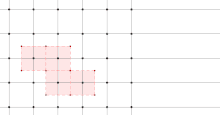Wigner–Seitz cell
The Wigner–Seitz cell, named after Eugene Wigner and Frederick Seitz, is a primitive cell which has been constructed by applying Voronoi decomposition to a crystal lattice. It used in the study of crystalline materials in solid-state physics.

The unique property of a crystal is that its atoms are arranged in a regular three-dimensional array called a lattice. All the properties attributed to crystalline materials stem from this highly ordered structure. Such a structure exhibits discrete translational symmetry. In order to model and study such a periodic system, one needs a mathematical "handle" to describe the symmetry and hence draw conclusions about the material properties consequent to this symmetry. The Wigner–Seitz cell is a means to achieve this.
A Wigner–Seitz cell is an example of a primitive cell, which is a unit cell containing exactly one lattice point. For any given lattice, there are an infinite number of possible primitive cells. However there is only one Wigner–Seitz cell for any given lattice. It is the locus of points in space that are closer to that lattice point than to any of the other lattice points.
A Wigner–Seitz cell, like any primitive cell, is a fundamental domain for the discrete translation symmetry of the lattice. The primitive cell of the reciprocal lattice in momentum space is called the Brillouin zone.
Definition
The Wigner–Seitz cell around a lattice point is defined as the locus of points in space that are closer to that lattice point than to any of the other lattice points.[1]
It can be shown mathematically that a Wigner–Seitz cell is a primitive cell. This implies that the cell spans the entire direct space without leaving any gaps or holes, a property known as tessellation.
The idea of the cell was first proposed by E. Wigner and F. Seitz in a 1933 paper, where it was used to solve the Schrodinger equation for free electrons in elemental sodium.[2]
Constructing the cell

The general mathematical concept embodied in a Wigner–Seitz cell is more commonly called a Voronoi cell, and the partition of the plane into these cells for a given set of point sites is known as a Voronoi diagram.
The cell may be chosen by first picking a lattice point. After a point is chosen, lines are drawn to all nearby (closest) lattice points. At the midpoint of each line, another line is drawn normal to each of the first set of lines.
In the case of a three-dimensional lattice, a perpendicular plane is drawn at the midpoint of the lines between the lattice points. By using this method, the smallest area (or volume) is enclosed in this way and is called the Wigner–Seitz primitive cell. All area (or space) within the lattice will be filled by this type of primitive cell and will leave no gaps.
For composite lattices, (crystals which have more than one vector in their basis) each single lattice point represents multiple atoms. We can break apart each Wigner–Seitz cell into subcells by further Voronoi decomposition according to the closest atom, instead of the closest lattice point.[3]
 The Wigner–Seitz cell of the Face-centered cubic lattice is a rhombic dodecohedron. |
 The Wigner–Seitz cell of the Body-centered cubic lattice is a trunctuated octohedron. |
Brillouin zone
In practice, the Wigner–Seitz cell itself is actually rarely used as a description of direct space, where the conventional unit cells are usually used instead. However, the same decomposition is extremely important when applied to reciprocal space. The Wigner–Seitz cell in the reciprocal space is called the Brillouin zone, which contains the information about whether a material will be a conductor, semiconductor or an insulator.
References
- ↑ Neil W. Ashcroft; N. David Mermin (1976). Solid State Physics. p. 73–75. ISBN 978-0030839931.
- ↑ E. Wigner; F. Seitz (15 May 1933). "On the Constitution of Metallic Sodium". Physical Review. 43 (10): 804. doi:10.1103/PhysRev.43.804.
- ↑ Giuseppe Grosso; Giuseppe Pastori Parravicini (2000-03-20). Solid State Physics. p. 54. ISBN 978-0123044600.